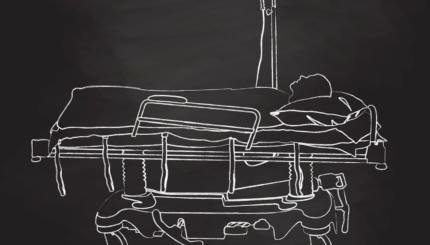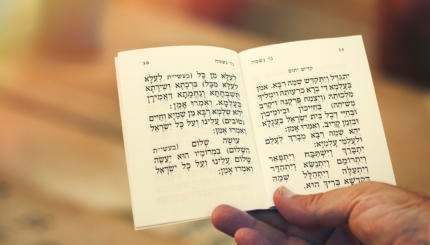The mourning laws are a concrete manifestation of the Judaic view of death; namely, that death desacralizes man because it is the end of the dynamic interaction with God that can take place only in life. Death removes man from an intimate relationship with God; he can no longer serve Him, he can no longer perform the mitzvot [commandments], he no longer possesses the nishmat chayim, the breath of life, which is the distinguishing characteristic of the human being.
Experience of Death Diminishes the Living
What of the surviving, living mourner, who alone among the living now knows what it is to experience the end of life and the termination of a meaningful relationship with God? In effect, the law asks the mourner to behave as if he himself were dead. He is now an incomplete person, and his daily life begins to reflect the fact of his incompleteness. His physical appearance and his body are neglected. His relationship with God is interrupted. He has no commonality or community with other men. The qualities and characteristics of a living human being are suspended.
According to the midrash, death is one of the aspects of human life which liken man to a beast. In death, man has witnessed the ultimate opposite of life, of God, and of man, and he cannot now summarily leave death behind him and return quickly and easily into the land of the living. He knows now what it is to be without the breath of the God of life, and he can return to normal life and to renewed contact with the sacred only by degrees.
In a word, the mourner must now live as an alien between the two worlds of life and death, moving imperceptibly from the defiled land of tumah [impurity] and death back toward sanctity and life.

Help us keep Jewish knowledge accessible to millions of people around the world.
Your donation to My Jewish Learning fuels endless journeys of Jewish discovery. With your help, My Jewish Learning can continue to provide nonstop opportunities for learning, connection and growth.
A careful examination of the specifics of the mourning legislation indicates that the laws would have the mourner react and behave in a manner consistent with that death force which he has just experienced. He has been touched by the antilife, and therefore he himself becomes less lifelike, less complete as a being. His brush with death causes him, at least for the moment, to lose his identity as a person and as a human. For just as death separates man from God, so it also separates man from the fraternity and community of other men, and separates man from his essential self, from his essence as a person.
In the face of death, man as a person, as an identity, as a being, as a living creature, as the image of God, ceases to exist. The rites of mourning are a physical expression of the essential facts of death. Thus the mourner, in his conduct, is devitalized, depersonalized, deidentified in his normal relationships and connections.
Mourning Customs Mimic Inner Estrangement
Therefore, he who has been involved with death and tumah refrains from participating in those aspects of life which express a relationship and connection with God, or fellowman, or himself. His essence as a person has been diminished, and thus he does not cut his hair, for the cutting of hair is a sign of man’s concern with his person. (The rabbis declare that an Israelite king was required to cut his hair daily, in order to maintain his dignity.) The mourner allows his hair to grow unattended and uncared for; there is no concern now with his physical is-ness.
For the same reason he allows his garments to become unclean. And at the moment of death and at the burial he rends the garment he is wearing–and wears that rent garment during the mourning period. Garments and man’s concern with them are manifestations of the fully living. For example, it is said of Rabbi Yohanan that he referred to his clothes as “my dignifiers.” That is, clothing dignifies and honors the wearer. As one who is now temporarily stripped of the dignity and honor of being a person, the mourner rends the symbol of this dignity. Further, as a manifestation of his status as a nonperson, he does not anoint or wash himself.
His is-ness as a person has been reduced, his identity as an individual has melted away, and he has no marital relations–which have the potential of creating a new life and a new identity–nor may he take a new wife.
His essence as a man has been decreased, and he walks barefoot, without shoes, in common with the beasts. 152a reports that a Sadducee once saw Rabbi Joshua without shoes and said, “One who is dead is better off than one who goes without shoes.”
He has been depersonalized and may not engage in work, since work sustains his life and is a manifestation of his person and of his connection with himself and with others.
He has been touched by desacralizing death and tumah,and he may not study which is called torat chayim–“the Torah of life” (Proverbs 3:2, 3:18, 4:22, 9:11)–and which is an aspect of God and which connects man with Him and His sacredness.
He has a diminished identity as a person and he does not sit, in the accepted mode of persons, on a chair or couch. He sits on the ground, in a configuration of lowness and diminution.
Because of the same consideration he refrains from sleeping in the normal mode: He “overturns the couch,” and as we have noted above, the reason for this is the concept of demut diyukni natati bakhem–“my image have I implanted in you.” The image of God within man has been affected by death. That is to say, once again, that death and tumah have “deimagized” man who was created in the image. By virtue of his contact with death and tumah, the demut diyukni–“the form of my image”–that which makes the essential man, has been diminished. Overturning or inverting the bed during the mourning period is a symbol of this depersonalization. “Turn over the middleman (the bed on which life is conceived),” says the Talmud.
For a similar reason, he does not prepare his own first meal following the burial. He has no relationship to himself, and at least at this one moment, he symbolically possesses no food. Only a fully living person prepares his own food. He may, if he desires, fast. But if he wishes to eat, the food must be prepared by others. And the menu must include such foods which remind him of the “nonperson” condition in which he finds himself.
Further depersonalization takes place. The head and face are covered. In effect, the mourner says: I do not exist; I am not I; I am an alien in the land of the living.
Because he is not “I,” he may not offer greetings–sh’elat (literally, “asking of peace”)–to his fellowman, nor may others offer greetings to him. He remains silent. Only a person, only an identity, can greet and be greeted in return. And shalom–the traditional greeting–is a symbol of community and fraternity. It is significant that shalom [peace] is also considered to be one of the appellations of the deity, according to Shabbat 10b: “Shalom is the name of the Holy One, Blessed be He.”
According to some opinions, greeting a mourner is permitted as long as the word shalom is not mentioned in the context of “peace unto you.” According to these opinions, at least, the desacralizing aspects of death and mourning are now clearly manifested: not only is shalom avoided because of its connotations of peace, community, and fraternity–of which the mourner is a direct opposite; shalom is avoided because of its additional connotations of the sacred, from which the mourner is now estranged.
In sum, the mourner is a diminished person, one who has been touched by the anti-life of tumah, and he sits in rent garments, on the ground, without shoes, unkempt, unwashed; he engages neither in work nor in study of Torah; his head and face are covered; he greets and recognizes no one and, in turn, is greeted and recognized by no one . And since he has experienced the desacralizing force of death, the mourner may not offer up a sacrifice for seven days.
The rigorous halakhah [Jewish legal framework] of mourning thus underscores, paradoxically, the heavy Judaic stress on life, and on man’s constant relationship with God, community, and himself. The dynamic interaction with God can take place only in the context of life; “the dead do not praise the Lord” (Psalms 115:); the mitzvot cannot be performed in a state of nonlife.
Excerpted with permission from Feldman’s essay “Death as Estrangement: The Halakhah of Mourning,” published in Jewish Reflections on Death, edited by Jack Riemer (Schocken Books).
Sign up for a Journey Through Grief & Mourning: Whether you have lost a loved one recently or just want to learn the basics of Jewish mourning rituals, this 8-part email series will guide you through everything you need to know and help you feel supported and comforted at a difficult time.
Looking for a way to say Mourner’s Kaddish in a minyan? My Jewish Learning’s daily online minyan gives mourners and others an opportunity to say Kaddish in community and learn from leading rabbis.



